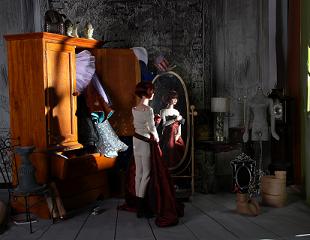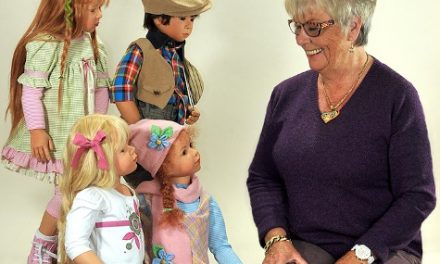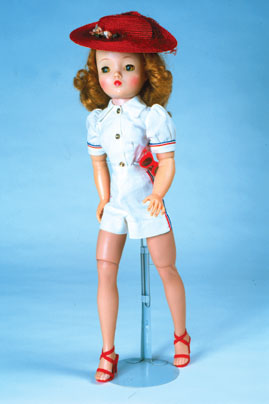Vita is, of course, a doll manufactured by Horsman Ltd. She was sculpted by Dorinda Balanecki and her jointing, unique in the fashion-doll world, was designed by Kenneth Young. Urban Vita burst on the fashion-doll scene with an open and joyful personality at a time when many dolls were pouting, a few even going so far as to snarl! Along with her friendly face, she possessed an ability to assume human poses which delighted the collector market. Her body style allowed her to share clothing with most of the dolls on the market at the time, which was a boon to longtime collectors who had amassed lots of fashions. Of course Vita also has her own extensive wardrobe.
Shortly after her introduction, she was produced as “Urban Vita Expressions” — a doll with changeable face plates which allowed her to change expression and added another dimension to her fantastic ability to pose. These additional sculpts also gave an exciting new palette to repaint artists. These face plates allow Urban Vita to change her eye color. The inset eyes are held in place by a small bracket inside the face plate. They are easily adjusted, giving even more expression to her face for collectors who love to photograph their dolls. So on one level, this is Urban Vita. But as true doll lovers know, this is just the vinyl and plastic that covers the real heart of the doll.
So who is Vita Richards?
Vita Richards was not always a style trendsetter with an enviable talent for combining the best looks of fashion through the decades. In fact, as a little girl, she would have been surprised if she could have looked into a crystal ball and seen where she is today. Spending most of her time in T-shirts and jeans, young Vita would never have believed that, one day, she’d be scooting through New York’s canyons of stone, glass, and steel in her Mini Cooper named “Dolly” while making a name for herself in the world of high finance. But I’m jumping ahead.
Born Aug. 9, 1983, Vita Richards grew up in Ann Arbor, Michigan, the only child of Valentina and Vinton Richards. She had a wonderful childhood, filled with adventures with her friends, good times with her family, and plenty of time to dream about what she’d do when she grew up. One of her favorite ways to pass the time when it was too rainy or snowy to play outside with friends was to go up to the attic of the big Victorian house in which three generations of the Richards family had lived. The house was built by her great-grandfather and left to her dad when his father died.
Over the years and generations, the attic had become a treasure trove of elegant old trunks and hat boxes tied with faded ribbon — all just waiting to be investigated and admired by a young girl. Often Vita would try on gowns and dresses, hats and gloves from generations past and dream that she lived in those days. Looking at the fine handwork and the beautiful fabrics of these pieces instilled what would be a life-long love of vintage fashion in the Vita’s heart. Even as an adult, her parents would tease her that, rather than coming home to visit them, she came home to go upstairs and play in her “treasure boxes.”
Vita was a good student and showed a surprising aptitude for both math and languages, which eventually led her to follow her parents’ wishes and study International Economics in her hometown, at the University of Michigan at Ann Arbor. Her girl-hood dream of living in a city like New York came true when she was hired by the investment firm of Seward-Wilkes to be a junior executive in their international division. So at 21, Vita bid farewell to her home and moved to the Big Apple!
As good fortune would have it, Vita’s college roommate, Zhonti, was doing an internship with one of the major TV networks in NYC, and they set up their first apartment together. The girls had great fun shopping for furniture and blending their design ideas into a place that was both functional and fabulous. As time passed, Zhonti’s career path would take her into film production and necessitate a move to Los Angeles to be near the heart of the industry.
Even though they hated to be a continent apart, it gave both young women a good excuse to practice ‘bi-coastal chic’ and visit each other’s home city as often as they could. By the age of 29, Vita had made a significant mark on the world of international finance and secured her future with Seward-Wilkes, while Zhonti had produced an award-winning short and her first feature-length film. Both were well on the way to great success.
It was fortunate that she loved to travel, because Vita’s work often took her to Europe or Asia for consultations with various financial firms. In each city, she would always try to make time to search out unique shopping locations. It was a rare trip that she not come home with several vintage treasures found hidden in quaint dusty stores languishing on a less-traveled side street in an elegant European capital.
Her mixing of fashion decades always gave the outfits that Vita wore a unique style and a more sophisticated flair than most of her contemporaries. When visiting LA, she always made a point of getting Zhonti to take her to see the fabulous clothing tucked away in the costume rooms at the studio where Zhonti was working. Vita often said that it was good they never left her there alone, as she found the costumes hard to resist!
While attending a high-level convention on International Trade and Economics in Oslo, Norway, an unexpected snowstorm delayed the opening meeting and gave Vita a mini-vacation. Glad that she always arrived a day early for these events, Vita contacted a local tourist agency and requested a guide who could help her discover all the delights of Oslo and the outlying regions. Vita’s guide, Ysla Larsen, suggested a visit to a small museum which housed a collection of bunander — Norwegian folk costumes.
The two women discovered that they shared a passion for fabric arts. During their travels over the two days before the conference opening, Vita discovered that Ysla’s hobby was knitting, and that she combined this skill with creating fabric collage using yarn and quilting along with beading and decorative hand stitching. In fact, one of Ysla’s art pieces was on display in a craft museum they visited.
A great friendship quickly developed between the two, and Vita promised herself a longer vacation in Oslo, while issuing a standing invitation for Ysla to visit her in New York. On her final day in Oslo, Ysla gave Vita a parting gift — one of her smaller art quilts. Vita was touched by this generosity, and the quilt, which she cherishes, is now hangs in her hallway to remind her of her faraway new friend.
No one has yet claimed Vita’s heart, but she has been seen about town on the arm of a screenwriter who worked on Zhonti’s latest film. Of course, she’s also been seen having cocktails with an up-and-coming attorney from one of the city’s top firms, and the paparazzi snapped her dancing with a charming cousin of Ysla Larsen, a dealer in Scandinavian furniture and art. Mrs. Richards would like Vita to find a nice young man and settle down, but only time will tell if she’ll get her wish. Meanwhile, Vita is enjoying every fashionable minute of her life in New York City.
To keep up with Vita, Zhonti and Ysla, read Vita’s blog at http://urban-vita.livejournal.com and take a look at the Horsman website, www.horsmanltd.com, to find all her clothes and furniture, and to bring home your own Vita, Ysla or Zhonti.









